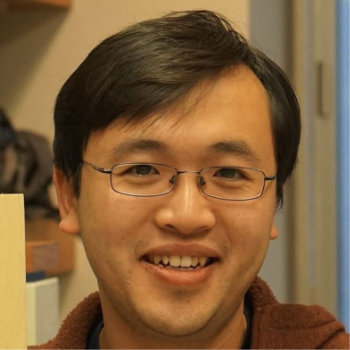Dr. Weihan LiWritten by: Dr. Monika Witzenberger  “Don’t be afraid to push yourself out of your comfort zone”, says Dr. Weihan Li, who is currently a postdoctoral researcher in Prof. Rob Singer’s lab at the Albert Einstein College of Medicine in New York. Having pushed himself out of the comfort zone, when transitioning from undergraduate studies in physics to earning a PhD in biochemistry and later undertaking a Postdoc in biophysics, he has gained a unique perspective on a wide range of research questions. “This journey has been incredibly rewarding!” Currently Dr. Li is excited about research questions the revolve around spatial gene expression, especially spatial regulation of mitochondrial gene expression. This regulation governs when and where genes are transcribed and translated and therefore is crucial for precise cellular functions such as organismal development, tissue formation and response to environmental stimuli. Despite the significance of spatial regulation, only a mere 0.1% of published research has described the spatial expression of mitochondrial DNA (mtDNA) .Dr. Li, who is currently on the academic job market, adds“I am committed to bridging this knowledge gap by leveraging my expertise in RNA single-molecule imaging, a cutting-edge technique that provides the essential high spatial resolution.” So, stay tuned for more exciting work on single molecule tracking of mRNA. For his work in Rob Singer’s lab, he has received the Dennis Shields Research award for excellence in research. Dr. Li began his scientific journey at Hong Kong Baptist University in the lab of Dr. Leihan Tang, where he spent his undergraduate physics degree using mathematical modelling to study the temporal oscillations in biological systems. When starting his Biochemistry PhD, he decided to take on a challenge and transition to experimental biology, because he wanted to test his ideas both in silico and at the bench. For this endeavor, Peter Walter's lab at the University of California San Francisco offered an amazing environment. “The transition from physics to biology was the greatest challenge in my career”, Dr. Li recalls. “During this process, senior members in the Walter lab guided me hand-in-hand to teach me the basic wet lab techniques. And I actively learnt from the mistakes that I made at the bench and persistently strived for improvement […]. By the time of graduation, I had been equipped with expertise in biochemistry, yeast cell biology, and organelle biology.” His PhD research focused on the endoplasmic reticulum (ER), which is the major folding compartment for secretory proteins and is vital for maintaining cellular function and preventing protein misfolding-related diseases such as multiple myeloma. In response to the accumulation of excessive unfolded proteins in the ER, cells activate two distinct mRNA processing pathways: nonconventional mRNA splicing and selective mRNA decay. These pathways share the same catalytic enzyme, making it challenging to dissect their individual biological functions. By trying to understand the molecular mechanism that differentiates the two pathways, Dr. Li discovered that the mRNA processing enzyme, Ire1, forms two types of homodimers, which correspondingly activate the two pathways Dr. Li hopes that “this insight will guide designing mammalian systems that favor mRNA splicing or decay, differentiating the pathways' biological significance.”
Following his PhD, Dr. Li made the choice to start a Postdoc in Biophysics in Rob Singer’s lab, which is renowned for its pioneering work in single molecule RNA imaging. His goal was to acquire skills in advanced imaging technology to complement his biochemistry expertise. Reflecting on his journey through different countries and different fields, Dr. Li expresses gratitude, stating “I've been fortunate to work with three exceptional mentors: Drs. Leihan Tang, Peter Walter and Robert Singer.” These mentors not only introduced him to scientific research and guided him through the transition from physics and biology, but also offered him mentorship in different areas such as leadership, grant-writing or scientific communication. Collectively these experiences have played an important role in shaping him into the researcher he is today, preparing him well for an independent investigator role. Comparing experiences in different locations, Dr. Li adds that researchers he interacted with in Hong Kong and the US were all equally dedicated and enthusiastic. However, he underscores the strong emphasis on scientific communication and presentation skills in the US, which he believes have had a positive impact on his career development and the effective communication of research findings in front of a broad audience. Because Dr. Li values scientific communication greatly, he co-founded the Einstein RNA Club together with Robert Singer, Sulagna Das and Dong Woo Hwang. This club unites RNA enthusiasts from over 20 labs and multiple departments to discuss a range of topics such as translation, transcription, RNA localization and development of new technologies. Furthermore, they also organized a one-day RNA Symposium with about 100 attendees from multiple institutes on the East coast. Dr. Li emphasizes “The Einstein RNA Club provides a platform where trainees can present their research, increase their visibility and network with scientists in the NYC area”. In addition to this initiative, Dr. Li actively champions scientific communication in the field of RNA biology at the ASCB|EMBO Annual Meetings, where he organized scientific sessions on “The Subcellular localization of RNA and Translation” in 2022 and 2023. You can get in contact with Dr. Weihan Li on Twitter @Weihan_Li_ or LinkedIn (www.linkedin.com/in/weihan-li-6667a83a) to talk more about single-molecule imaging, spatial regulation of gene expression and scientific communication. He can also tell you more about why his favorite RNA is the Hac1/Xbp1 mRNA. Dr. Li’s favorite RNA Journal article is titled “Ribosome-bound Upf1 forms distinct 80S complexes and conducts mRNA surveillance” by Ganesan and colleagues, which elegantly elucidates the early steps of the nonsense-mediated mRNA decay (NMD) pathway. |
